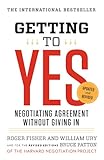Getting to yes
Negotiation is the heart of collaboration. It is what makes conflict potentially meaningful and productive for all parties. Getting To Yes is the seminal book on negotiation. It’s the deep dive into win win or no deal and seek first to understand. The formal, be hard on problems and soft on people, then focus on the desired outcomes not the positions, next get more options on the table, and make sure you measure by objective criteria - lastly know your BATNA.Several years later a new book came out by a hostage negotiator. Instead of being analytic focus, it’s all about influencing the elephant.
Getting To Yes
Hard on problems soft on people
Let compassion be a guide.
When someone throws a rock at you, you don’t get mad at the rock, you get mad at the person. But no one wants to throw a rock at you, they likely did it due to their suffering. So, just as you don’t get mad at the rock, don’t get mad at the person, get mad at their suffering
Focus on outcomes not positions
Brainstorm options
Find objective criteria
Know your BATNA
Best Alternative to Negotiated Agreement. Essentially what you get if you don’t reach an agreement. If your BATNA exceeds what you’d get in the negotiation, you should walk away and take your BATNA. E.g.
Imagine you’re negotiating with Jerry on selling a knife. If Jerry doesn’t take the knife you can always sell the knife to Bob for 100$, so if Jerry gives you less than 100$, you can walk away and sell it to Bob.
Also check out Getting to yes with yourself
Never Split the difference
Another book on negotiation. This one is less about logic, and more about feelings. Some good ideas here as well.
Mirroring and active listening
Chapter 2, you’ll learn how to avoid the assumptions that blind neophyte negotiators and replace them with Active Listening techniques like Mirroring, Silences, and the Late-Night FM DJ Voice. You’ll discover how to slow things down and make your counterpart feel safe enough to reveal themselves; to discern between wants (aspirations) and needs (the bare minimum for a deal); and to laser-focus on what the other party has to say.
Tactical Empathy and Labeling
Chapter 3 will delve into Tactical Empathy. You’ll learn how to recognize your counterpart’s perspective and then gain trust and understanding through Labeling—that is, by repeating that perspective back to them. You’ll also learn how to defuse negative dynamics by bringing them into the open. Finally, I’ll explain how to disarm your counterpart’s complaints about you by speaking them aloud in an Accusation Audit. Next, in
Chapter 4, I’ll examine ways to make your counterpart feel understood and positively affirmed in a negotiation in order to create an atmosphere of unconditional positive regard. Here, you’ll learn why you should strive for “That’s right” instead of “Yes” at every stage of a negotiation, and how to identify, rearticulate, and emotionally affirm your counterpart’s worldview with Summaries and Paraphrasing.
Chapter 5 teaches the flip side of Getting to Yes. You’ll learn why it’s vitally important to get to “No” because “No” starts the negotiation. You’ll also discover how to step out of your ego and negotiate in your counterpart’s world, the only way to achieve an agreement the other side will implement. Finally, you’ll see how to engage your counterpart by acknowledging their right to choose, and you’ll learn an email technique that ensures that you’ll never be ignored again.
In Chapter 6, you’ll discover the art of bending reality. That is, I’ll explain a variety of tools for framing a negotiation in such a way that your counterpart will unconsciously accept the limits you place on the discussion. You’ll learn how to navigate deadlines to create urgency; employ the idea of fairness to nudge your counterpart; and anchor their emotions so that not accepting your offer feels like a loss. After this,
Chapter 7 is dedicated to that incredibly powerful tool I used at Harvard: Calibrated Questions, the queries that begin with “How?” or “What?” By eliminating “Yes” and “No” answers they force your counterpart to apply their mental energy to solving your problems. In
Chapter 8 I demonstrate how to employ these Calibrated Questions to guard against failures in the implementation phase. “Yes,” as I always say, is nothing without “How?” You’ll also discover the importance of nonverbal communication; how to use “How” questions to gently say “No”; how to get your counterparts to bid against themselves; and how to influence the deal killers when they’re not at the table. At a certain point, every negotiation gets down to the brass tacks: that is, to old-school haggling.
Chapter 9 offers a step-by-step process for effective bargaining, from how to prepare to how to dodge an aggressive counterpart and how to go on the offensive. You’ll learn the Ackerman system, the most effective process the FBI has for setting and making offers. Finally,
Chapter 10 explains how to find and use those most rare of negotiation animals: the Black Swan. In every negotiation there are between three and five pieces of information that, were they to be uncovered, would change everything. In this chapter, you’ll learn how to recognize the markers that show the Black Swan’s hidden nest, as well as simple tools for employing Black Swans to gain leverage over your counterpart and achieve truly amazing deals.
